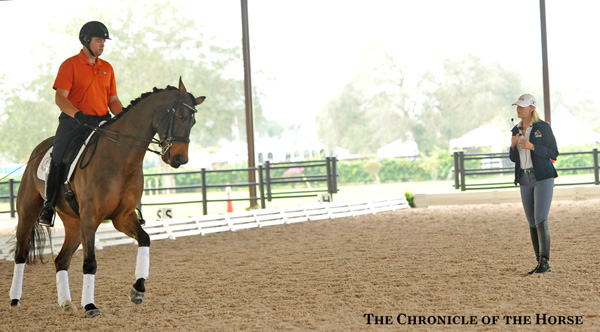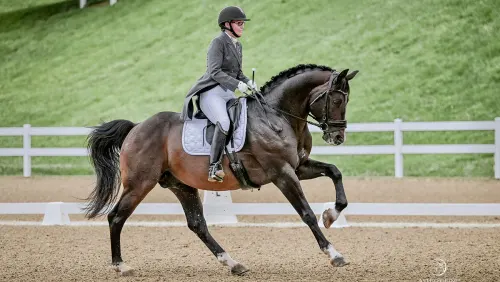Wellington, Fla.—Jan. 8
The best thing you can do for your horse is to teach him self-carriage. But that doesn’t mean you should throw the reins away and leave your horse to fend for himself. Horse training is all about testing—seeing where your horse and then bringing him back before things start to fall apart.
The importance of self-carriage was stressed throughout the fourth day of the 2016 Robert Dover Horsemastership Clinic.
After the horses had a day off yesterday while riders sat through a series of presentations from vets Rick Mitchell and Hilary Clayton, judge Janet Foy and Jane Savoie, everyone was eager to get back in the tack.
The riders switched instructors and will continue with their new trainer tomorrow. Today Olympic medalists Charlotte Bredahl-Baker and Steffen Peters joined Dover at the Global Dressage Festival showgrounds.
When Anna Weniger’s third level mount Izeffia stiffened and resisted through transitions, Peters encouraged her to go back to the basics, so the mare would learn she couldn’t take advantage of a softer contact. The pair focused on getting a round soft frame in the halt whenever the mare stiffened her topline in the walk before moving forward again, and it resulted in a quieter mouth and a steadier and rounder shape.
“You’re teaching her about self-carriage,” said Peters. “You want her not just accepting the bit but respecting the bit. When she starts fussing, don’t make it a big deal but address it. ‘You don’t need to fuss in the bridle.’ Discuss it in a clear way—not too firm but very quick. Horses have a short attention span.
“So many horses learn it is their mission in life is to resist the bridle,” he said. “When you ask for a half halt and you’re not happy with the answer, find a place where the half halt is understood.”
The pair moved onto lengthenings in the trot, and Peters again stressed the importance of testing the mare’s self carriage and suppleness.
“It has nothing to do with leaning on the bridle more and throwing the legs everywhere. It has everything to do with self carriage,” he said. “Even if you have to repeat it three or four times, it’s no big deal, but you can’t let her get away with it.
“I know she can do a lengthening, but can she do a lengthening in self carriage?” he asked.
Peters once again stressed the importance of self carriage in Molly Paris’ lesson on her new U25 mount Countess. Since the mare was further along in her training, he had them test self carriage through piaffe to collected trot transitions. He encouraged Paris to pick where she asked for the half steps, relying on her to understand when the mare needed to change her balance.
“The question isn’t forward, that’s easy” he said. “The question is can you go forward with control.”
Peters also stressed the importance of really paying attention to the mare’s extended walk and always riding for a 9 in their schooling. If Paris places emphasis on it, eventually a 9 extended walk will become habit which will then translate to the show ring.
“You’re educating with the leg,” he said. “You’r not just holding it there. That’s what dressage is all about.”
ADVERTISEMENT
Self Confidence Is Key
Fifteen-year-old Asia Ondaatje Rupert brought Firmamento owned by the Matute family to her lesson with Dover and from the beginning he discussed the need to encourage sensitivity in horses. Though he wants riders to come to the ring with a whip, Dover has them put it down until it becomes necessary to use it as a reminder since whips aren’t allowed during a test.
“He’s trained enough that if you think the aid he better giddy up. If you squeeze and it doesn’t work, you give a stronger action,” he said.
Going forward into their lesson, Dover wanted Rupert to picture not being a junior rider, but being a superstar Grand Prix rider.
“I said this to Allison [Nemeth] who’s 13 and I think you’ll appreciate this too. Think that you’re Charlotte Dujardin. Stop thinking that you’re Allison,” he said. “Charlotte Dujardin was 13 too at one point and then Carl [Hester] had her and said, ‘You ride just like you’re me. Think like you’re me. What would I do?’ And she starts going, ‘I know what I can do. I’m tough. I know what I want. I want you to be just like Carl’s horses.’
“If you talk to her, she’ll tell you she’ll outride Carl in a heartbeat. She’ll tell you that. She’s got that kind of ego,” he continued. “You’ve got to be humble but inside your head you’ve got to say, “I’m the best in the world, and I’m going to train this horse and I’m going to out train the others.’ You’ve got to believe that.”
 |
Robert Dover explained to Asia Ondaatje Rupert that we often take away sensitivity from our horses, but we want them to respond to the slightest aids so we need to make them hot to the leg.
Throughout their session, whenever the gelding didn’t give a swift enough reaction, Dover reminder her that Dujardin wouldn’t wait to make a correction, she’d have it done within the next stride.
“If you think he’s dull and believe it, then you’re going to be dull,” Dover explained. “You have to say, ‘Nope! We’re going to dance around.’ If you kick, he better be galloping forward like a wild Indian.”
Dover also told Lilly Simons to pretend her Dutch Warmblood was Valegro after a weak transition to an extended trot.
“I want you to see Valegro,” he said. “When I saw extended trot, you saw the word ‘extended trot.’ I want you to see the video of the best extended trot ever in you mind.”
Dover encouraged Simons to make her horse jig in the walk, so that Willoughby could start progressing towards Grand Prix work even though they’re still doing Young Rider tests.
“Grand Prix mentality starts interestingly from the beginning of training, and I know it sounds funny. It’s not that we say 3-year-olds should do the Grand Prix, but the 3-year-old, once you’re broke and you’re not bucking me off, we ask little questions and found out what they’re reactions are and reward them and then when we start feeling the reaction, you put it away in the cupboard and we know it.
“So every once in a while we just [try it] and they react and ‘Oh good boy,’ and then we put it away in the cupboard,” he said.
ADVERTISEMENT
Exercises in Suppleness
In Cassidy Gallman’s lesson on her U25 mount, Bredahl-Baker encouraged her to use curves in her warm-up, including both shallow and deep serpentines at the trot and canter, to encourage the gelding to work on lateral suppleness.
“Have a rubber band feel in your hand,” she said. “It’s not a loose rein, but an elastic rein.”
She then had Gallman work on a series of shallow leg yields to the rail into a half pass back to the quarter line before ending on a quarter turn at around the leg.
“It’s not steep. Focus on forward and bend. You want to feel him getting up and under and feeling honest in the contact,” Bredahl-Baker said.
Bredahl-Baker gave similar advice to Nick Hansen as he and Ritter Benno worked through their walk and canter pirouette work. At the canter, she had the pair riding a square, while performing quarter turns in the corners. Anytime the horse got stuck, she encouraged Hansen to ride forward into a medium canter.
They then moved into a pirouette with a leg yield out once they’d gotten a few nice steps.
“Don’t get too strong in the outside rein. You have to allow him to turn,” she said as the horse’s haunches fell in during the exercise. “Try to keep the hind legs snappier and push the inside leg out.”
|
|
Bredahl-Baker encouraged several riders to pay attention to how tight their curb rein was as many mounts were curling behind the vertical.
“Stay off the curb,” she implored. “That’s like riding with the emergency brake on.”
All three clinicians encouraged riders to stop thinking about the piaffe and passage together, instead having riders to go between the piaffe and a collected trot and the passage and a medium trot.
“You want to separate piaffe and passage,” said Bredahl Baker. “Do it where he’s always thinking that medium is next. You want him mentally always thinking I’m going to trot.”
Want more from Robert Dover? Check out day 2 from the clinic and pick up a copy of the January 25 issue of the Chronicle.















